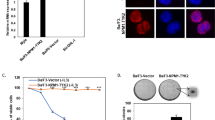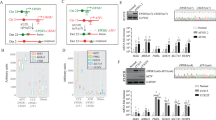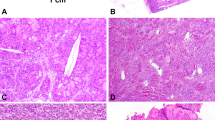Abstract
A recurrent chromosomal abnormality associated with a subset of papillary renal cell carcinomas is t(X;1)(p11;q21). This translocation leads to the formation of two fusion genes, TFE3PRCC and the reciprocal product PRCCTFE3. Both fusion genes are expressed in t(X;1)-positive renal cell carcinomas and contain major parts of the coding regions of the parental transcription factor PRCC and TFE3 genes, respectively. To find out whether these fusion genes possess transforming capacity, we transfected NIH3T3 and rat-1 cells with the fusion products, either separately or combined. When using soft agar assays, we observed colony formation in all cases. NIH3T3 cells transfected with PRCCTFE3 or PRCCTFE3 together with TFE3PRCC yielded the highest colony forming capacities. Examination of other characteristics associated with malignant transformation, i.e., growth under low-serum conditions and formation of tumors in athymic nude mice, revealed that cells transfected with PRCCTFE3 exhibited all these transformation-associated characteristics. Upon transfection of the fusion products into conditionally immortalized kidney cells, derived from the proximal tubules of an H-2Kb-tsA58 transgenic mouse, and consecutive incubation under non-permissive conditions, growth arrest was observed, followed by differentiation except for those cells transfected with PRCCTFE3. Therefore, we conclude that PRCCTFE3 may be the t(X;1)-associated fusion product that is most critical for the development of papillary renal cell carcinomas.
This is a preview of subscription content, access via your institution
Access options
Subscribe to this journal
Receive 50 print issues and online access
$259.00 per year
only $5.18 per issue
Buy this article
- Purchase on Springer Link
- Instant access to full article PDF
Prices may be subject to local taxes which are calculated during checkout






Similar content being viewed by others
References
Auffray C, Rougeon F . 1980 Eur. J. Biochem. 107: 303–314
Beckmann H, Kadesch T . 1991 Genes Dev. 5: 1057–1066
Carcao MD, Taylor GP, Greenberg ML, Bernstein ML, Champagne M, Hershon L, Baruchel S . 1998 Med. Pedr. Oncol. 31: 153–158
de Jong B, Molenaar IM, Leeuw JA, Idenburg VIS, Oosterhuis JW . 1986 Cancer Genet. Cytogenet. 21: 165–169
Desangles F, Camparo P, Fouet C, Houlgatte A, Arborio M . 1999 Cancer Genet. Cytogenet. 113: 141–144
Dijkhuizen T, van den Berg E, Wilbrink M, Weterman MAJ, Geurts van Kessel A, Storkel S, Folkers R P, Braam A, de Jong B . 1995 Gene Chromo. Cancer 14: 43–50
Hernandez-Marti MJ, Orellana-Alonso C, Badia-Garrabou L, Verdeguer Miralles A, Paradis-Alos A . 1995 Cancer Genet. Cytogenet. 83: 82–83
Kovacs G, Wilkens L, Papp T . 1988 Cytogenet. Cell Genet. 48: 242–243
Meloni AM, Dobbs Jr RM, Pontes JE, Sandberg AA . 1993 Cancer Genet. Cytogenet. 65: 1–6
Perot C, Bougaran J, Boccon GL, Storkel S, Leverger G, van den AJ, Taillemite JL, Couturier J . 1999 Cancer Gene Cytogenet. 110: 54–56
Rabbitts TH . 1994 Chromosomal translocations in human cancer Nature 372: 143–149
Roman C, Matera AG, Cooper C, Artandi S, Blain S, Ward DC, Calame K . 1992 Mol. Cell. Biol. 12: 817–827
Sidhar SK, Clark J, Gill S, Hamoudi R, Crew AJ, Gwilliam R, Ross M, Linehan WM, Birdsall S, Shipley J, Cooper CS . 1996 Hum. Mol. Genet. 5: 1333–1338
Sorensen PHB, Triche TJ . 1996 Semin. Cancer Biol. 7: 3–14
Thoenes W, Stoerkel S, Rumpelt HJ . 1986 Path. Res. Pract. 181: 125–143
Thompson AD, Teitell MA, Arvand A, Denny CT . 1999 Oncogene 18: 5506–5513
Tonk V, Wilson KS, Timmons CF, Schneider NR, Tomlinson GE . 1995 Cancer Genet. Cytogenet. 81: 72–75
van den Berg E, van der Hout AH, Oosterhuis JW, Stoerkel S, Dijkhuizen T, Dam A, Zweers HMM, Mensink HJA, Buys CHCM, de Jong B . 1993 Int. J. Cancer 55: 223–227
Weterman MAJ, van Groningen JJM, Jansen A, Geurts van Kessel A . 2000 Oncogene 19: 69–74
Weterman MAJ, Wilbrink M, Dijkhuizen T, van den Berg E, Geurts van Kessel A . 1996a Hum. Genet. 98: 16–21
Weterman MAJ, Wilbrink M, Geurts van Kessel A . 1996b Proc. Natl. Acad. Sci. USA 93: 15294–15298
Zent CS, Mathieu C, Claxton DF, Zhang DE, Tenen DG, Rowley JD, Nucifora G . 1996 Proc. Natl. Acad. Sci. USA 93: 1044–1048
Acknowledgements
This work was supported by the Dutch Cancer Society, grant 98-1804. We thank Dr R Bindels (Dept. Cell Physiology), Ad de Groof and Frank Oerlemans (Dept. Cell Biology) for their advice regarding the establishment of the conditionally immortalized cell lines. Stef Mentzel and Dr KJM Assmann (Dept. Pathology) are gratefully acknowledged for providing the aminopeptidase A and dipeptidyl peptidase IV specific primers. Liesbeth Pierson (Dept. General Instrumentation) is acknowledged for capturing the images of the conditionally immortalized cell lines.
Author information
Authors and Affiliations
Rights and permissions
About this article
Cite this article
Weterman, M., van Groningen, J., den Hartog, A. et al. Transformation capacities of the papillary renal cell carcinoma-associated PRCCTFE3 and TFE3PRCC fusion genes. Oncogene 20, 1414–1424 (2001). https://doi.org/10.1038/sj.onc.1204213
Received:
Revised:
Accepted:
Issue Date:
DOI: https://doi.org/10.1038/sj.onc.1204213
Keywords
This article is cited by
-
Nuclear translocation of ASPL-TFE3 fusion protein creates favorable metabolism by mediating autophagy in translocation renal cell carcinoma
Oncogene (2021)
-
TFE3 fusions escape from controlling of mTOR signaling pathway and accumulate in the nucleus promoting genes expression in Xp11.2 translocation renal cell carcinomas
Journal of Experimental & Clinical Cancer Research (2019)
-
Molecular genetics and cellular features of TFE3 and TFEB fusion kidney cancers
Nature Reviews Urology (2014)
-
Role of PSF-TFE3 oncoprotein in the development of papillary renal cell carcinomas
Oncogene (2007)
-
The genetic make-up of renal cell tumors
Urological Research (2004)



